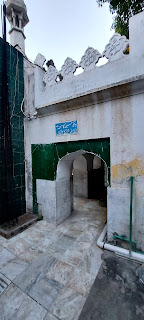(All images copyright 2022 Mirza Ali Usman Baig, text written in this article is the author's Research)
The grave of Shaikh Muhammad Ismail, also known as Mian Wadda, is nestled one mile south of the exquisite Shalimar Gardens. During the reign of Akbar, in the year 1008 A.H. (1599 A.D.), Shaikh Muhammad Ismail constructed an adjoining school, known as Madrassa, with the primary aim of imparting Quranic education. The Madrassa boasted numerous cells to accommodate faqirs (Sufi ascetics) and a splendid mosque.
Shaikh Muhammad Ismail was born in the year 995 A.H. (1586 A.D.) as the son of Fatehulla, grandson of Abdullah, and great-grandson of Sarfaraz Khan. He became a devoted disciple of Makhdum Abdul Karim, a revered Muslim saint from Langar Makhdum on the banks of the Chenab River. With time, Shaikh Muhammad Ismail acquired immense knowledge and wisdom, establishing his Madrasa in the Mohalla Telpura, situated in the suburbs of Lahore. This esteemed institution provided comprehensive education in theology, jurisprudence, Hadis (sayings of the Prophet Muhammad), and Tafsir (commentary on the Quran). Thousands of individuals benefited from the teachings of this renowned scholar and moralist, who gained widespread recognition far and wide.
Shaikh Muhammad Ismail passed away in the year 1095 A.H. (1683 A.D.), during the reign of Aurangzeb, having lived for a century. In accordance with his wishes, no dome was erected over his grave. To ensure the sustenance of his institution, Aurangzeb generously granted a vast tract of land.
In addition to his remarkable legacy, it is worth noting that Muhammad Ismail, hailing from the village of Tarkranm in Potohar, held the esteemed title of hafiz-e-Quran (someone who has memorized the entire Quran). His father, Fateh Ullah, descended from a line of agriculturists and rests in peace in the village of Jabba on the Chenab River. Mian Wadda's family relocated to Langay, where he commenced his educational journey under the tutelage of the revered Muslim saint, Makhdum Abdul Karim.
After serving under Makhdum's guidance, Muhammad Ismail embarked on his Quranic studies in Langay and subsequently moved to Lahore. In Lahore, he found himself at Tailipura mosque, which had relatively low attendance, yet his spirit remained restless. Upon receiving counsel from a devout individual, he embarked on a forty-day retreat, known as chilla-nashini, at the mausoleum of Data Ganj Bakhsh—a revered saint. The impact of this spiritual journey was profound, as the mosque in Tailipura became so inundated with students that it necessitated a relocation to another mosque west of the Daras area.
Shaikh Muhammad Ismail's final resting place is his grand mausoleum, situated on Shalamar Link Road in Lahore, Pakistan. This sacred site serves as a testament to his unwavering commitment to the Quran, his extensive contributions to education, and his enduring influence on knowledge and spirituality.















No comments:
Post a Comment